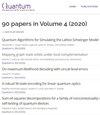远非完美:(超不变)均匀码的量子纠错
IF 5.1
2区 物理与天体物理
Q1 PHYSICS, MULTIDISCIPLINARY
引用次数: 0
摘要
我们引入了一类新的量子比特码,我们称之为偶数码,建立在先前的超不变张量网络的提议之上。它的张量网络描述由局部的、非完美的张量组成,这些张量描述了点缀着Hadamard门的CSS代码,放置在双曲$\{p,q\}$几何上,偶$q\geq 4$,产生无限大的子系统代码类。我们构造了一个$\{5,4\}$流形的例子,并描述了导致不同速率$k/n$和距离$d$的逻辑规范固定策略,我们对其进行了分析计算,找到了范围从$d=2$到$d \sim n^{2/3}$的距离。研究了在擦除、去极化和纯泡利噪声通道下的阈值性能,我们发现代码的去极化噪声阈值约为19.1% in the code-capacity model and 50% for pure Pauli and erasure channels under suitable gauges. We also test a constant-rate version with $k/n = 0.125$, finding excellent error resilience (about 40%) under the erasure channel. Recovery rates for these and other settings are studied both under an optimal decoder as well as a more efficient but non-optimal greedy decoder. We also consider generalizations beyond the CSS tensor construction, compute error rates and thresholds for other hyperbolic geometries, and discuss the relationship to holographic bulk/boundary dualities. Our work indicates that Evenbly codes may show promise for practical quantum computing applications.本文章由计算机程序翻译,如有差异,请以英文原文为准。
Far from Perfect: Quantum Error Correction with (Hyperinvariant) Evenbly Codes
We introduce a new class of qubit codes that we call Evenbly codes, building on a previous proposal of hyperinvariant tensor networks. Its tensor network description consists of local, non-perfect tensors describing CSS codes interspersed with Hadamard gates, placed on a hyperbolic $\{p,q\}$ geometry with even $q\geq 4$, yielding an infinitely large class of subsystem codes. We construct an example for a $\{5,4\}$ manifold and describe strategies of logical gauge fixing that lead to different rates $k/n$ and distances $d$, which we calculate analytically, finding distances which range from $d=2$ to $d \sim n^{2/3}$. Investigating threshold performance under erasure, depolarizing, and pure Pauli noise channels, we find that the code exhibits a depolarizing noise threshold of about 19.1% in the code-capacity model and 50% for pure Pauli and erasure channels under suitable gauges. We also test a constant-rate version with $k/n = 0.125$, finding excellent error resilience (about 40%) under the erasure channel. Recovery rates for these and other settings are studied both under an optimal decoder as well as a more efficient but non-optimal greedy decoder. We also consider generalizations beyond the CSS tensor construction, compute error rates and thresholds for other hyperbolic geometries, and discuss the relationship to holographic bulk/boundary dualities. Our work indicates that Evenbly codes may show promise for practical quantum computing applications.
求助全文
通过发布文献求助,成功后即可免费获取论文全文。
去求助
来源期刊

Quantum
Physics and Astronomy-Physics and Astronomy (miscellaneous)
CiteScore
9.20
自引率
10.90%
发文量
241
审稿时长
16 weeks
期刊介绍:
Quantum is an open-access peer-reviewed journal for quantum science and related fields. Quantum is non-profit and community-run: an effort by researchers and for researchers to make science more open and publishing more transparent and efficient.
 求助内容:
求助内容: 应助结果提醒方式:
应助结果提醒方式:


